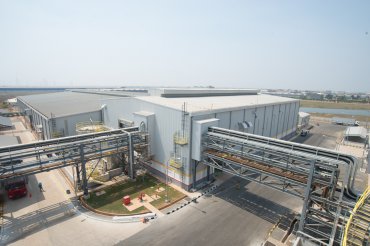Lubricant blenders in Indonesia have an enormous amount of surplus capacity – more than 50 percent, according to government officials – and the overbuild is increasing as plant construction continues and demand lags.
But suppliers and analysts say the slack should eventually lessen due to an upturn in the economy and regulations that will restrict imports.

Photo courtesy of Shell
Shell’s new blending plant north of Jakarta adds to the surplus of domestic production capacity in Indonesia’s lubricant market.
In 2014, the sprawling archipelago consumed approximately 765,000 metric tons of lubricants, according to Harjanto, an official with the nations Ministry of Industry. By comparison, he added, there are 20 lubricant blending plants in Indonesia with combined capacity of 1.8 million tons per year.
Moreover, the market is a significant net importer. Ipsos Business Consulting Indonesia estimates that 48 percent of the finished lubes consumed in 2014 were imports, Senior Consulting Manager Domy Halim told Lube Report Asia. He added that the value of those lube imports was estimated at U.S. $354 million, far more than the $85 million estimated value for finished lube exports.
The surplus capacity shows no signs of deterring blenders from continuing to build. Harjanto, who uses just one name and serves as the ministrys director general for chemicals, textiles and other industries, provided some of his data during a November ceremony for the opening of Shells first blending plant in Indonesia, which has capacity of 120,000 t/y.
Indonesia has excess lubricant blending capacity with only half of it being used for domestic consumption and a very small percentage for exports. Although lubricant market will become more competitive as the low rate of capacity utilization is expected to continue, analysts and industry players expect the Indonesian market to grow when the countrys economy recovers and a national lubricant standard is implemented.
The domestic market amounted to only 850,000 kiloliters per year, so production capacity is 47 percent of that amount, said Harjanto, Director General for Chemical Industry, Textile and Other, representing the Ministry of Industry at the opening of the new Shell lubricant blending plant in November. National oil company Pertamina already has two blending domestic plants and is building a 350,000 t/y plant in Jakartas Tanjung Priok port area.
We anticipate the large excess capacity issue will persist in the near future, Domy added.
The surplus capacity does put pressure on blenders, market insiders said. New brands and companies will be affected, said Johanes Haryanto, CEO of domestic blender PT Wiraswasta Gemilang. The [blender] without a brand or [toll customer] can end up in bankruptcy.
Domy added, Players who are not able to establish brand presence and distribution network for the new market will face a difficulty to improve their utilization rate.
To beat the competition, he continued, Lubricant players will be expanding into different sectors. The players who are a leader in the motorcycle lubricants are expected to diversify into passenger vehicle oils, for example. Gradually, once they establish their presence in the new territory, other new market segments such as commercial vehicle and industrial lubricants will also provide opportunities for growth.
One example is local motorcycle lubricant manufacturer, PT Federal Karyatama, which launched its passenger car motor oils brand, Federal Mobil, this year. Meanwhile, bigger players like Shell and Pertamina Lubricants will focus more on exporting products to other markets within the region.
Shells new Marunda blending plant [was built] with the aim of exporting within Asia, Domy said. The third blending plant that Pertamina is building is part of their expansion aspiration to become one of the leading brand in the ASEAN market. This is taking advantage of the ASEAN Economic Community that allows free tariffs for intra-ASEAN trade. ASEAN, the Association of Southeast Asian Nations, consists of 10 countries.
In recent years, Indonesia has been one of the worlds fastest-growing, significantly sized lubricant markets, a trend that undoubtedly contributed to the installation of blending capacity there. That growth has stalled recently, however, due to a slowdown in the nations economic growth. The Asian Development Bank recently lowered its economic growth forecast for Indonesia from 5.5 percent to 4.9 percent, partly due to unexpectedly low spending on infrastructure projects. In the first half of 2015, the bank said, the national government disbursed only 10 percent of the funds budgeted for such projects this year.
As economic growth in Indonesia slows down, the challenge that lubricant players might have in managing their excess capacity is the likelihood of customers prolonging lube change [intervals], Domy said. We anticipate this phenomenon is contributing to the decline in the lubricant sales in 2015. This is especially true for passenger car and motorcycle lubricants. This could potentially widen [increase] the excess capacity level.
At the same time, there seems to be consensus that long-term prospects for Indonesias lubricant market remain bullish. The main reason is ongoing confidence in the nations economy. We are expecting an increase in market growth in the future and better growth in the domestic economy, said Johanes.
In addition, the Indonesian Government is considering establishing a national standard for lubricants, and this may restrict import volumes. According to Brenda Karnadi, associate consultant for Ipsos, the ministries of Industry and Energy and Mineral Resources are developing a standard.
Once implemented, lubricants that do not meet these standard requirements are not allowed to enter Indonesia market, she said. This is aimed at protecting domestically produced lubricant against imported brands and products. [With] the implementation of national standard requirements, the number of companies importing is expected to fall.